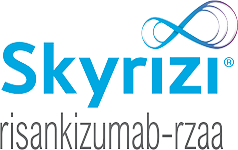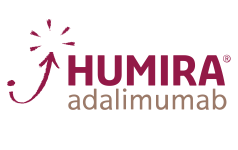For adult patients with active psoriatic arthritis (PsA)
Reducing signs and symptoms, inhibiting the progression of structural damage, and improving physical function in active PsA1
ADEPT
Adult patients with active PsA who had an inadequate response to NSAIDs1,2
ADEPT study design intro: Double-blind trial of adult patients with active PsA who had an inadequate response to NSAIDs. 313 patients were randomized to receive HUMIRA 40 mg EOW (n=151) or placebo (n=162). The co-primary endpoints were ACR20 response rate at Week 12 and change from baseline mTSS at Week 48 vs placebo at Week 24.1,2
ACR=American College of Rheumatology; EOW=every other week; mTSS=modified total Sharp score; NSAIDs=nonsteroidal anti-inflammatory drugs
Radiographic progression: 48 weeks1-3
Co-primary endpoint
- HUMIRA 40 mg EOW (n=133)
- Placebo (n=141)
Extrapolated analysisa
aFor subjects who were randomized to HUMIRA and did not have a mTSS at Week 48, mTSS was imputed by linear extrapolation using the baseline and Week 24 scores. The mTSS, which included distal interphalangeal joints, was used by the readers blinded to treatment group to assess the radiographs.1,3
bP<0.001 HUMIRA at Week 48 vs placebo at Week 24
EOW=every other week; mTSS=modified total Sharp score; OLE=open-label extension; RCT=randomized controlled trial
Radiographic progression: 24 weeks3
9/10 PsA patients showedNO radiographic progression
VS
7/10 on placebo at 24 weeksa
- HUMIRA 40 mg EOW (n=144)
aAs defined by △mTSS ≤0.5: 91.0% of HUMIRA-treated patients (n=131/144); 71.1% (n=108/152) of patients treated with placebo
EOW=every other week; mTSS=modified total Sharp score
Signs and symptoms: ACR response at Week 241,2
ACR=American College of Rheumatology
- Responses were similar in patients who were or were not receiving concomitant MTX therapy at baseline.1
Signs and symptoms: ACR response rates at 2 years6
HUMIRA 40 mg EOW (n=281)
- ACR20
- ACR50
- ACR70
LOCF analysisa
aLast observation carried forward (LOCF) analysis based on the duration of exposure to HUMIRA (including those patients originally randomly assigned to placebo).
- Over 90% of RCT patients elected to enroll in the OLE.6
OLE LIMITATIONS
As with any long-term OLE, there are several limitations with the OLE portion of this study. For example, there is the potential for enrichment of the long-term data in the remaining patient population, as those who remain in the study generally fare better than those who discontinue.
ADEPT OLE STUDY DESIGN INTRO
285 patients from the ADEPT trial enrolled in the OLE at Week 24. All patients received HUMIRA 40 mg EOW.6
ACR=American College of Rheumatology; OLE=open-label extension; RCT=randomized controlled trial
Physical function: HAQ-DI at Weeks 12 and 241,2
- HUMIRA 40 mg EOW (n=151)
- Placebo (n=162)
P<0.001
LOCF analysisa
aLast observation carried forward (LOCF) analysis of intent-to-treat (ITT) population.
The MCID (minimum clinically important difference) for HAQ-DI is defined as a ≥0.3-point decrease from baseline in clinical trials.6,b
bHealth Assessment Questionnaire Disability Index (HAQ-DI) at baseline: HUMIRA=1.0; placebo=1.0.
ACR=American College of Rheumatology; EOW=every other week; mTSS=modified total Sharp score
Skin clearance: Week 241,2*
59%
VS
1%
PASI75a
42%
VS
0%
PASI90b
- HUMIRA 40 mg EOW (n=69)
- Placebo (n=69)
aP<0.001
bP<0.001
*PASI was assessed only for patients with psoriatic skin involvement of at least 3% body surface area at baseline.
EOW=every other week; NSAIDs=nonsteroidal anti-inflammatory drugs; OLE=open-label extension; PASI=Psoriasis Area and Severity Index; RCT=randomized controlled trial
Safety data: 24 Weeks7
Adverse reaction rates observed in clinical trials may not predict the rates observed in a broader patient population in clinical practice.
| HUMIRA (n=151) PYs=68.8 |
Placebo (n=162) PYs=73.6 |
|
| Serious infection | 1.5 | 1.4 |
| Malignancya | 0 | 0 |
| Active tuberculosis | 0 | 0 |
| Lymphoma | 0 | 0 |
aExcluding non-melanoma skin cancer and lymphoma.
RISK OF SERIOUS INFECTION1
Patients treated with HUMIRA are at increased risk for developing serious infections that may lead to hospitalization or death. Most patients who developed these infections were taking concomitant immunosuppressants such as methotrexate or corticosteroids.
Carefully consider the risks and benefits of treatment with HUMIRA prior to initiating therapy in patients with chronic or recurrent infection. Monitor patients closely for the development of signs and symptoms of infection during and after treatment with HUMIRA.
- Do not start HUMIRA in patients with an active infection, including localized infections
- Patients older than 65 years, patients with co-morbid conditions, and/or patients taking concomitant immunosuppressants may be at greater risk of infection
RISK OF MALIGNANCY1
Lymphoma, including a rare type of T-cell lymphoma, and other malignancies, some fatal, have been reported in patients treated with TNF blockers, including HUMIRA.
- Consider the risks and benefits of HUMIRA treatment prior to initiating or continuing therapy in patients with a known malignancy
- More cases of malignancies were observed among HUMIRA-treated patients compared to control patients in clinical trials
RISK OF TUBERCULOSIS1
Patients treated with HUMIRA are at increased risk for developing serious infections that may lead to hospitalization or death, including active tuberculosis (TB), including reactivation of latent TB. Patients with TB have frequently presented with disseminated or extrapulmonary disease.
- Test patients for latent TB before HUMIRA use and during therapy. Initiate treatment for latent TB prior to HUMIRA use
- Monitor patients closely for the development of signs and symptoms of infection during and after treatment with HUMIRA, including the development of TB in patients who tested negative for latent TB infection prior to initiating therapy
RISK OF LYMPHOMA1
Lymphoma and other malignancies, some fatal, have been reported in children and adolescent patients treated with TNF blockers, of which HUMIRA is a member.
Postmarketing cases of hepatosplenic T-cell lymphoma (HSTCL), a rare type of T-cell lymphoma, have occurred in adolescent and young adults with inflammatory bowel disease treated with TNF blockers including HUMIRA.
- The rate of lymphoma in controlled and uncontrolled clinical trials of HUMIRA in patients with RA, PsA, AS, CD, UC, Ps, HS and NI uveitis* was approximately 3-fold higher than expected in the general population
- Patients with RA, particularly those with highly active disease, are at a higher risk for the development of lymphoma
*Non-infectious (NI) intermediate, posterior, or panuveitis
ADEPT study design intro: Double-blind trial of adult patients with active PsA who had an inadequate response to NSAIDs. 313 patients were randomized to receive HUMIRA 40 mg EOW (n=151) or placebo (n=162). The co-primary endpoints were ACR20 response rate at Week 12 and change from baseline mTSS at Week 48 vs placebo at Week 24.1,3 285 patients from the RCT enrolled in the OLE at Week 24. All patients received HUMIRA 40 mg EOW.4
ACR=American College of Rheumatology; EOW=every other week; mTSS=modified total Sharp score; NSAIDs=nonsteroidal anti-inflammatory drugs; OLE=open-label extension




